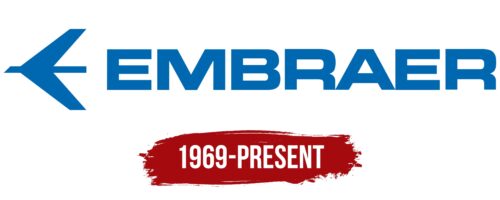The Embraer logo is like the wings of Brazil. Simple yet full of meaning, each curve and line is like a piece of the Amazon River or the rhythms of the samba, transformed into a sign you can trust in the sky. This logo is not just a drawing; it reflects Embraer’s entire journey, like a book of stories about flying machines written since 1969. It’s as if Brazil is sharing its natural beauty and warm spirit with everyone as it rises into the clouds. And Embraer did not stay in Brazil but crossed the oceans. From small airplanes to large ones, each with a sense of Brazilian flair.
Embraer: Brand overview
The history of Embraer began in 1969, when the Brazilian government founded the company as Empresa Brasileira de Aeronáutica (Brazilian Aeronautics Company) on August 19. The main goal was to develop and produce aircraft for Brazil’s military and civil aviation needs. Initially, the company focused on creating light turboprop planes for the local market.
The first model, the EMB 110 Bandeirante, was a twin-engine aircraft for 15-21 passengers, inspired by the French Max Holste MH.1521 Broussard airliner. This aircraft made its debut flight in 1968 and quickly gained popularity among regional airlines in Brazil and neighboring countries.
In the 1970s, the company continued to introduce new aircraft models. For instance, in 1974, they launched the EMB 200 Ipanema, an agricultural aircraft designed for spraying fertilizers and pesticides. During this time, the company undertook its first international project involving the licensed production of the Italian Aermacchi MB-326 trainer aircraft for the Brazilian Air Force. A significant milestone was achieved in 1980 with the introduction of the company’s first jet-powered passenger aircraft, the EMB 120 Brasilia. This 30-seat turboprop airliner was created to meet the increasing demand in the regional aviation market and quickly gained international success, with major orders coming from American regional airlines like Atlantic Southeast Airlines and Comair. Throughout the 1980s, the company expanded its range of aircraft, including developing the EMB 312 Tucano, a popular turboprop trainer and light attack aircraft sold to over 15 countries globally. Additionally, the company began working on its first regional jet airliner, the ERJ 145.
The early 1990s were challenging for the company due to Brazil’s economic crisis and reduced defense orders, leading to financial struggles. Consequently, the Brazilian government decided to privatize the company in December 1994, selling it to a consortium of Brazilian and international investors to secure the necessary capital for further growth. Following privatization, the company experienced rapid expansion.
In 1996, the 50-seat ERJ 145 regional jet was introduced and quickly became one of the most popular regional aircraft globally, with significant orders from US and European airlines.
In the early 2000s, the company expanded its family of regional jets with new models such as the ERJ 135, ERJ 140, ERJ 170, and ERJ 190, known for their modern design, fuel efficiency, and passenger comfort. In addition to its success in commercial aviation, the company entered the business jet market in 2000 by introducing its first corporate aircraft, the Legacy 600, based on the ERJ 135. This was followed by the launch of popular models like the Phenom 100, Phenom 300, Legacy 450, and Legacy 500, which gained traction among corporate clients and private owners. Throughout the 2000s and 2010s, the company continued its global expansion by establishing assembly plants in China and the US, expanding its service centers worldwide, and forming partnerships with industry leaders like Boeing and Lockheed Martin for major international projects.
In 2018, the company unveiled a new generation of regional jets, the E-Jet E2 series, which includes models like the E175-E2, E190-E2, and E195-E2. These aircraft feature enhanced aerodynamics, new engines, and advanced avionics, reducing fuel consumption and operating costs. The first deliveries of the E-Jet E2 series began in 2019.
Throughout its 50-year history, the company has transformed from a small state-owned entity into one of the world’s leading aircraft manufacturers.
Meaning and History
What is Embraer?
Founded in 1969 in the city of São José dos Campos (São Paulo State), Embraer has become a global titan of the aerospace industry. The Brazilian multinational has consistently ranked as the world’s third-largest civilian aircraft manufacturer, proudly standing alongside industry flagships such as Boeing and Airbus. Focusing on the production of commercial, military, executive, and agricultural airplanes, the company has expanded into a wide range of aviation services.
1969 – today
A company that manufactures aircraft and provides aviation services has a stylized image of an airplane on its logo. It is a small blue silhouette pointing to the left. To the right of this silhouette is the word “EMBRAER” in the same blue color. The font used to type this word is similar to MicroSquare Bold Extended from FontSite Inc.
The silhouette of the airplane pointing to the left speaks of the movement and foresight needed to work in the aerospace industry. The unified blue color scheme of the text and the aircraft symbolizes the unity and reliability required for an organization working with complex technology and human safety. The choice of a font similar to MicroSquare Bold Extended gives the logo a modern, clean look that evokes a sense of precision and technology. It is designed to inspire confidence in customers and partners.





